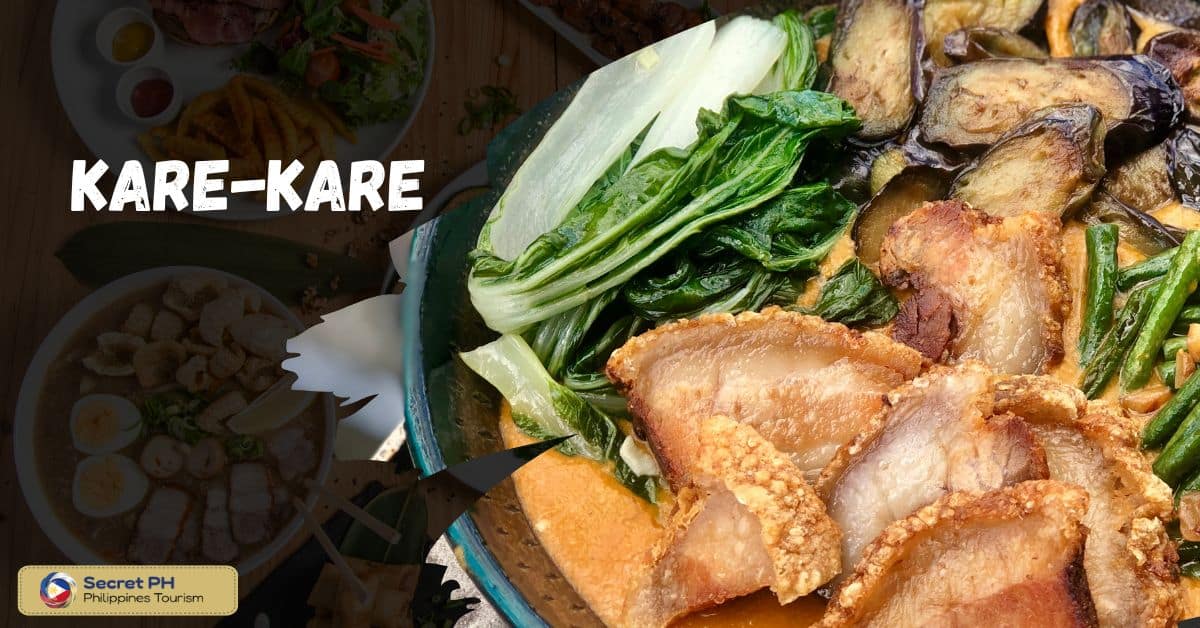Indulge in a nutritious and delicious feast with Philippine cuisine. With a rich cultural history, Philippine cuisine offers a wide range of dishes that are not only healthy but also delicious. From adobo to sinigang, Filipino food is made with fresh ingredients like rice, seafood, leafy greens, and spices, creating a balance of flavors and nutrients to nourish your mind and body.
On this blog, we will be exploring authentic Filipino cuisine and unlocking the secrets behind making the perfect plate of Philippine delicacy. Join us on our journey as we discover more about where this food comes from and why it’s been delighting folks from around the world for centuries!

Benefits of Traditional Philippine Dishes
Traditional Philippine dishes are full of flavor, heritage, and nutrition. The combination of herbs and spices used in cooking can provide a range of health benefits, from improved digestion to enhanced immunity. Many traditional Philippine recipes also use fresh ingredients such as perennials, wild-growing vegetables, and fish that have been carefully tended to by diverse cultures throughout Philippine history.
These dishes also offer cultural enrichment because they are usually specific to a certain region or province in the country. Each recipe brings its own unique flavor and texture that is hard to find in modern processed foods. Consuming these traditional Filipino meals helps support local communities as they provide employment opportunities and help sustain their food production systems. Traditional Philippine dishes not only taste delicious but also embody culture and provide essential health benefits.

Key Ingredients in Philippine Cuisine
Philippine cuisine has been heavily influenced by the Spanish colonizers, Chinese traders, Mexicans and Americans. This melting pot of countries can be tasted in the wide variety of dishes that make up this country’s culinary identity. The key ingredients used in most Filipino dishes are:
Rice
Rice is an integral part of Philippine cuisine, and one of the key ingredients in many dishes. It is rich in carbohydrates and provides essential vitamins and minerals for nutrition, providing a base for this flavorful cooking. Rice is usually boiled to be served as a side dish accompaniment or used as a main ingredient in flavorful stir-fries or vegetable dishes.
Whether steamed, fried, with vegetables or seafood, rice has been at the center of almost every traditional Filipino meal for centuries. It is believed that rice has been around since ancient times and is a large part of Filipino heritage. As well as being popular in Philippines culture, it is also one of the most widely consumed food products worldwide.

Seafood
Key ingredients such as fish and shellfish are used in the vast array of Filipino dishes, including popular staples like sinigang and adobo. Most commonly prepared with rice or cooked in soups, it creates a delightful flavor combination perfect for individuals who crave something light yet flavorful.
Combined with a host of fresh vegetables, seafood also provides a nutritious meal that can incorporate multiple vitamins and minerals. As one of the main dietary sources in the Philippine islands, seafood promises to bring out the best in every meal.

Coconut milk and vinegar
Coconut milk and vinegar are staples in the Philippine cuisine. A combination of these two ingredients create a savory flavor that is unrivalled by any other. Coconut milk is derived from the flesh of coconuts which are cut, boiled, and processed to form a thick and creamy liquid while vinegar is made from sugar cane or palm sap that has been fermented with bacteria.
Together, they make a perfect base for many dishes, providing both essential flavors and nutritional benefits. Whether used in soups, stews, sauces or curries, the combination of coconut milk and vinegar is unquestionably one of the key ingredients in Philippine cuisine.

Leafy greens and vegetables
Leafy greens and vegetables are key ingredients in Philippine cuisine, bringing freshness and counterbalancing the other flavorful components. Vegetables such as squash, eggplants, and okra provide essential vitamins and minerals that help fuel your body and keep you feeling energized.
There are endless possibilities to prepare leafy greens and vegetables, from salads to stir fries. No matter which way it’s cooked, these colorful ingredients will not only add vibrancy to your plate but also provide additional flavor that enhances the overall meal.

Spices and seasonings
Spices and seasonings are key ingredients that bring flavors to life in Philippine cuisine. From the sourness of Kalamansi to the richness of Garlic, spices and seasonings can make a dish even more sumptuous and fully flavorful.
These ingredients are also essential in the local dishes that most Filipinos enjoy, especially Pinoy delicacies like sinigang, Bicol Express, Kare-Kare and more! Their strong aromas add an extra depth of flavor for any kind of local Filipino dishes.

Popular Healthy Dishes in Philippine Cuisine
Philippine cuisine is a rich fusion of indigenous, Spanish, and Asian influences and is known for its variety of delicious, healthy dishes. Here are some of popular healthy dishes in Philippine cuisine:
Adobo
Adobo is a Philippine dish steeped in history and culture. It is considered the national dish of the country, and contains its own unique characteristics that make it unique within Philippine cuisine. Adobo consists of meat, seafood, or vegetables simmered in a marinade of vinegar, garlic, soy sauce, peppercorns and bay leaves for an array of distinct flavors.
Often times other ingredients like brown sugar or laurel leaves can also be added to enhance its distinctive taste. Versatility is also an important trait of adobo; through the use of different proteins and creative combinations it can be tailored to anyone’s particular tastes. All these qualities combined create a gastronomic experience unlike any other Philippine dish.

Sinigang
Sinigang is a Philippine Cuisine dish known for its various flavors. Created by simmering tamarind, tomatoes, onions, and other vegetables in a hot soup base with the addition of fresh ingredients like fish, pork, beef, or shrimp. It has an unmistakable sourness from the tamarind that gives it an unforgettable flavor. It can be served together with steamed rice for a complete meal. It’s simplicity and unique flavor make Sinigang one of the most beloved Philippine dishes.

Kare-kare
Kare-kare is a Philippine cuisine that originated in the Pampanga province. It is a stew made up of oxtail, vegetables topped with a peanut sauce. The cooking process of kare-kare takes several hours as it calls for low and slow cooking to tenderize the oxtails and vegetables. The two main vegetables used for Philippine style Kare-kare are string beans and eggplant to which shrimp paste, garlic, onion and various spices are added for seasoning.
To give its distinct flavor, the stew is served with a thick peanut sauce made from ground peanuts or peanut butter paired with annatto oil. Although not traditionally served as a main meal, Kare-kare has become an all-time favorite among Philippine households as a party dish or part of their lifestyle cuisine.

Tinola
Tinola is a classic Philippine dish that has been enjoyed by families for generations. It is a simple and flavorful dish featuring chicken, vegetables, ginger, garlic, and chili peppers. Its signature flavor comes from combinations of fish sauce and patis or vinegar. Tinola can be made with beef or pork if preferred, and even topped off with meaty chicharo beans. This traditional Philippine cuisine is sure to make your taste buds come alive!

Bicol express
Bicol Express is a unique Philippine dish from the Bicol region of southeastern Luzon. The Philippine cuisine is known for its use of chili peppers, coconut milk and shrimp paste. Bicol Express features all of these ingredients and is composed of shredded pork, onions, garlic and green or red chilis that have been sautéed with shrimp paste for extra flavor.
As the name implies, it packs a bit of heat as well – but this can be adjusted by changing the chili pepper to suit anyone’s heat preference. Once cooked, Bicol Express is served with plenty of white rice. This filling dish has become increasingly popular in Philippine restaurants around the world over the years, making it a staple on menus everywhere.

Tips for Making Healthy Choices in Philippine Cuisine
Discover how to incorporate healthy options into traditional Philippine cuisine with these helpful tips. Learn to make nutritious choices while still enjoying delicious and familiar flavors.
Use fresh ingredients whenever possible
Opting for fresh ingredients when cooking Philippine cuisine offers a myriad of health benefits. Every bite you take can be more nutritious and better tasting when using natural and recently picked items. Think of meals as your body’s fuel and start making conscious decisions with the choices you make.
Making healthy decisions include buying organic fruits and vegetables, choosing lean proteins such as fish, poultry, legumes, and eggs, using herbs and spices to flavor dishes instead of processed condiments, extra virgin olive oil as the main source of fat and avoiding packaged snacks as much as possible.

Limit sodium and added sugars
Making healthy choices around sodium and added sugars is essential in Philippine cuisine. The majority of foods and beverages are high in salt or sweeteners that can contribute to an increased risk for chronic diseases such as heart disease and type 2 diabetes.
There are simple steps we can take to cut back on these unhealthy ingredients. Reducing the consuming of processed, high-salt content food is a great start to cutting back on sodium intake. Opting for natural sweeteners over table sugar or other artificial sweeteners can have a positive impact as well.

Reduce the amount of fat used to cook with
Reducing the amount of fat used to cook with is one way to ensure that what you eat is good for you and your family. By utilizing different methods of cooking, like baking or steaming, food can be prepared without adding any unnecessary fat.
Making use of spices can also be beneficial as they give flavor while not adding extra calories or cholesterol. Making conscientious decisions about what fats are used in food preparation will help to create nutritious meals that are sure to please the whole family.

Substitute healthier alternatives when possible
Substituting healthier alternatives for typical ingredients can make a world of difference in the overall nutritional value of a dish. For instance, white rice can be replaced with brown or red rice, which contains more fiber and essential vitamins and minerals.
Similarly, vegetable oil can be used in lieu of butter or lard to reduce saturated fat intake during cooking. Making sensible substitutions like these will help you enjoy flavorful meals while making healthier dietary choices.

Choose leaner cuts of meat
Making healthy choices in Philippine cuisine often begin with the type of meat and seafood the individual is using. Leaner cuts of meat are far better for your health since they are typically lower in fats, including saturated fats – all of which can potentially increase chances for heart disease.
Making lean cuts of meat such as poultry or pork loin can reduce unhealthy fats while still offering delicious and fulfilling dishes. Not only does leaner meats bring fewer dangers, but it’s also much easier to cook. Making a safe, delicious meal with healthier options has never been easier or tasted better.

Avoid deep frying whenever possible
Deep frying is not the healthiest option as it significantly increases the caloric and fat content of the food being cooked. Healthy cooking methods like steaming, simmering or sautéing are great choices that require little to no oil and help preserve the nutrient content of the ingredients used. Making this shift in cooking style can go a long way in making healthier eating options without compromising flavorful dishes.

In Conclusion
Making healthy food choices is essential for nourishing both our minds and our bodies. The cuisine of the Philippines has a wide range of mouth-watering, nutritious options to choose from. Whether enjoying traditional dishes like tinola chicken soup or adobo pork cooked in vinegar, coconut milk and herbs, making healthy choices from these cultural recipes can provide important vitamins and minerals to keep us energized.
From appetizing fruit salads full of Vitamin C to nutty kare-kare vegetable stew enriched with proteins, vitamins and minerals, Philippine cooking offers a variety of options to ensure you are taking care of your health while delighting your taste buds.








